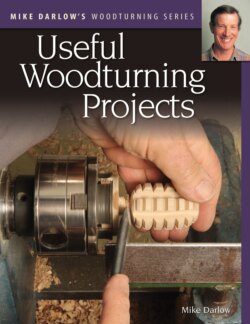Читать книгу Mike Darlow's Woodturning Series: Useful Woodturning Projects - Mike Darlow - Страница 7
Chapter 1 INTRODUCTION
ОглавлениеMy objectives with this book are to revive the turning of useful items, and to inspire readers to seek other useful turning subjects.
In the first four books of my woodturning series I covered the techniques of hand woodturning. The fifth book in the series, Turned Chessmen published in 2004, was my first project book. It was forecast to flop by a woodwork book marketing expert. 16 years after publication it continues to sell well. Feedback from buyers confirms that the book’s background and history content have been a major factor in the book’s success, being appreciated both by the turners, and, when passed on, by the users of those chess sets. This second project book continues that approach, and will thus, I hope, interest even those readers who aren’t about to undertake any of its projects.
Instead of focussing on one type of useful turning, this book’s projects cover a wide range. Some might consider that range too esoteric. My excuses are that it mirrors my own interests in turning, and illustrates the scope to explore.
The interest in turning useful projects has waned in recent decades. I believe that if turners increase the proportion of useful items in their output they would:
• enjoy their turning at least as much
• gain the potential to enjoy using the turnings they keep
• find that their turnings were better appreciated by others.
By useful I mean ‘can be used for other than aesthetic, contemplative or emotion-creating purposes’. A useful turning’s usefulness may be entirely due to the turning, as in a pastry-cook’s rolling pin. At the other extreme the turning may only add three-dimensional ornament to an item which is no less useful without the turning. Of course useful turnings aren’t always bought to be used—most buyers of Japanese tea caddies, such as those in figure 1.1, now buy them as ornaments and souvenirs and continue to make their tea with tea bags.
How to describe turnings which aren’t useful in the way I’ve described? My dictionary of antonyms offers useless as the antonym of useful. However, aesthetic, contemplative and emotion-creating purposes are valid and certainly not useless. For want of a better term, I shall therefore describe turnings which aren’t useful as non-useful.
Many now live in surroundings in which the only relatively unaltered natural substances are the air and the tap water. Wood is an obsolescent (becoming obsolete) material, and therefore woodturning is an obsolescent skill. But, if you’re reading this, you’ve probably already decided to disregard this truth and continue enjoy using a lathe to shape wood.
Figure 1.1 Three Japanese-style tea caddies turned from European ash (Fraxinus excelsior). They have incurved flanges so that the finely powdered green tea doesn’t billow into the air when the lid is lifted, not tugged, off. The top of the lid is almost flat, and during the tea ceremony a bamboo teaspoon or chashaku rests on it. In the bottom is a recess to grip on the hand.
The Japanese words for tea caddy are chaire and chaki. This type is a natsume, and is used to store the powdered tea for making thin tea.
Figure 1.2 A chair with at least eight designs of identical spindle.
I contend that during recent decades the hand turning of useful items has declined relative to that of non-useful items. As evidence I cite the 1921 edition of Paul Nooncree Hasluck’s The Wood Turner’s Handybook.1 Every turning pictured in it is useful as figures 1.2 and 1.3 demonstrate. In contrast, today’s woodturning often features non-useful bowls and vessels and the non-turning techniques which are used to apply two-dimensional decoration and three-dimensional ornament.
It’s true that during the last 50 years woodturning as an artisan and industrial technique to produce useful items (mainly components for buildings, furniture and woodware) has declined, but not disappeared. It’s also true that during that time hobby woodturning has increased in popularity, and it’s undoubtedly true that part of that increase is because woodturning has been increasingly promoted as a technique which can be exploited to create Fine Art. In many examples though the turning is a subsidiary technique used to provide a base for the decoration and ornament.
Figure 1.3 A towel rail constructed from five designs of identical turning.
I fully support this widening of woodturning’s horizons and ambitions, but not the associated:
• neglect of the potential for useful turnings to be rewarding turning subjects
• narrowing of the range of turning skills which turning teachers offer to beginners and which beginners seek to acquire, and which has thus resulted in a smaller proportion of turners being able to turn useful items
• neglect of pre-turning design.
In this first chapter I’ll discuss these changes by considering:
• why the growth in non-useful turning has occurred
• why, in parallel, turning of useful items has declined
This chapter then concludes with some housekeeping matters.
